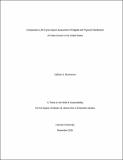| dc.contributor.author | Buonocore, Cathryn E. | en_US |
| dc.date.accessioned | 2017-08-30T13:06:23Z | |
| dc.date.created | 2016-11 | en_US |
| dc.date.issued | 2016-11-07 | en_US |
| dc.date.submitted | 2016 | en_US |
| dc.identifier.citation | Buonocore, Cathryn E. 2016. Comparative Life Cycle Impact Assessment of Digital and Physical Distribution of Video Games in the United States. Master's thesis, Harvard Extension School. | en_US |
| dc.identifier.uri | http://nrs.harvard.edu/urn-3:HUL.InstRepos:33797406 | |
| dc.description.abstract | This study examines and compares the environmental footprint of video game distribution on last generation consoles, current generation consoles and personal computers (PC). Two different methods of delivery are compared on each platform: traditional retail on optical discs and digital downloads in the U.S. Downloading content has been growing and is used to distribute movies, music, books and video games. This technology may change the environmental footprint of entertainment media. Previous studies on books, music, movies and television shows found that digital methods of distribution reduced emissions. However, prior research on video games, looking only at previous generation consoles, found the opposite conclusion.
In this thesis, life cycle assessment (LCA) is used to measure all background and foreground emissions with the U.S. EPA’s TRACI 2.1 framework. Data is gathered through a combination of previous work and experimental power consumption data gathering. Results are also tested with four different sensitivity analyses. I found that digital distribution resulted in lower emissions for last generation consoles across all TRACI 2.1 impact categories, but were mixed on current generation consoles and PC. Once results were normalized, digital distribution had higher emissions for the TRACI 2.1 categories with significant impact factors than their physical counterparts. Sensitivity analysis indicated that increasing energy efficiency of data transfer over time and smaller file sizes prevalent in downloads generated emissions below or comparable to the physical cases. Normalized sensitivity cases demonstrated this to also be true for the TRACI 2.1 impact categories with the highest impact factors.
Further research into internet infrastructure, manufacturing practices for physical media, and consumer behavior may help to better clarify the potential impacts of downloading and streaming as they continue to grow in predominance and user share as a method of entertainment media distribution. | en_US |
| dc.format.mimetype | application/pdf | en_US |
| dash.license | LAA | en_US |
| dc.subject | Environmental Sciences | en_US |
| dc.title | Comparative Life Cycle Impact Assessment of Digital and Physical Distribution of Video Games in the United States | en_US |
| dc.type | Thesis or Dissertation | en_US |
| dash.depositing.author | Buonocore, Cathryn E. | en_US |
| dc.date.available | 2017-08-30T13:06:23Z | |
| thesis.degree.date | 2016 | en_US |
| thesis.degree.discipline | Sustainability | en_US |
| thesis.degree.grantor | Harvard Extension School | en_US |
| thesis.degree.level | Masters | en_US |
| thesis.degree.name | ALM | en_US |
| dc.contributor.committeeMember | Norris, Gregory | en_US |
| dc.contributor.committeeMember | Leighton, Mark | en_US |
| dc.type.material | text | en_US |
| dash.identifier.vireo | http://etds.lib.harvard.edu/dce/admin/view/306 | en_US |
| dc.description.keywords | Life cycle assessment; sustainability; foot printing; technology; video games; environment; health; information technology | en_US |
| dash.author.email | cebuonocore@gmail.com | en_US |
| dash.identifier.orcid | 0000-0001-7688-9684 | en_US |
| dash.contributor.affiliated | Buonocore, Cathryn | |
| dc.identifier.orcid | 0000-0001-7688-9684 | |


